Many stores now choose composable commerce to give people a better customer experience. This method works well in many situations, but stores must think carefully about the trade-offs. This article looks at the differences between composable commerce and traditional commerce models, showing the good and bad sides of each. Understanding these differences helps stores decide which method best fits their needs and goals. As people’s preferences change, stores face new technical methods and strategies, making composable commerce a popular choice for many.
What is Composable Commerce?
Composable commerce is a new method for ecommerce platform development that involves selecting and combining modular technologies to generate customized solutions. This method enables enterprises to select best-in-class vendors for certain functionality, hence increasing flexibility, agility, and scalability.
Composable commerce enables organizations to develop customizable and personalized ecommerce experiences that can respond to shifting market demands and client preferences. By separating down each business necessity into independent software components, composable commerce provides independence for every facet of the commerce operating system.
Key Aspects of Composable Commerce
Here’s a breakdown of the key aspects:
- Modular Components: Allows for flexibility and scalability by dividing the commerce platform into interchangeable components. Allows for customization and rapid deployment of new features.
- API-Driven Integration: Facilitates seamless connectivity between different systems and applications. API-driven Integration ensures compatibility and data interchange across several platforms.
- Headless: Separates the front-end presentation layer with the back-end commerce logic. Headless commerce enables multichannel experiences and speedier innovation by developing front-end interfaces independently.
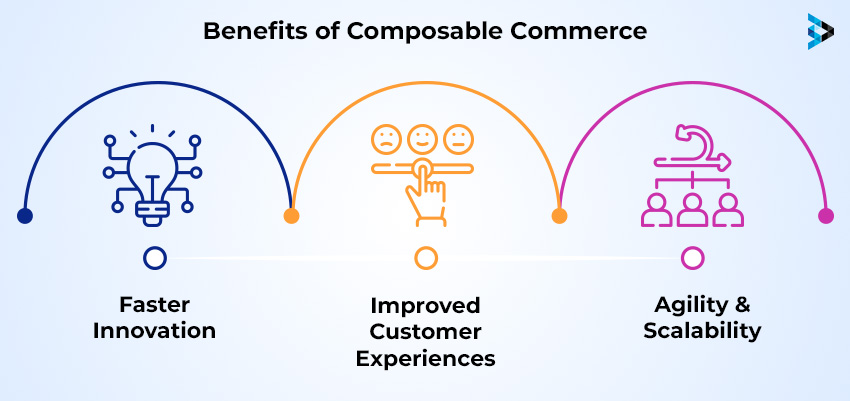
Benefits of Composable Commerce
69% of brands have installed a composable commerce approach for their businesses. Composable commerce has the following benefits for the businesses due to its future proof architecture:
Faster Innovation:
- Composable Commerce enables enterprises to swiftly test, iterate on, and deliver new features and capabilities.
- Decoupling various components allows an Adobe Commerce developer to operate independently and release changes more regularly.
- This accelerates the speed of innovation and allows businesses to stay ahead of the competition.
Improved Customer Experiences:
- Composable Commerce allows enterprises to provide highly individualized and bespoke experiences to their customers.
- The architecture’s modular design enables seamless integration of best-in-class tools and services.
- Using Adobe Composable Commerce leads to a more cohesive and engaging consumer experience across all touchpoints.
Agility & Scalability:
- Composable Commerce gives organizations the ability to adapt to changing market conditions and client demands.
- The modular architecture enables for easy scaling up and down of certain components as needed.
- This agility enables firms to respond swiftly to new opportunities while remaining competitive in a continually changing landscape.

Can I Go Composable with Adobe Commerce?
Yes, you can go composable with Adobe Commerce, formerly known as Magento, is an ecommerce platform that gives businesses flexibility and scalability. It incorporates modular construction components, enabling customized solutions that may respond to changing client needs and market trends. This method enables organizations to improve their ecommerce solution by leveraging external tools, capabilities, and services, resulting in greater agility, efficiency, and ease of updating. Adobe Commerce also makes it simple to switch between tools and functions in order to provide excellent consumer experiences across digital channels.
The Adobe Composable Commerce Platform helps companies sell things online. It has many tools businesses can use to customize their online stores. Adobe’s platform has great features that make it easy for companies to create online stores that work well for them. Adobe composable commerce platform provides your business with:
Strong Foundation for Composable Commerce
The Adobe Composable Commerce Platform is built on a solid basis that adheres to composable commerce concepts. Composable commerce is the idea of using the best tools for an online store. It lets stores pick what they want, not one big tool. This lets stores change and grow their website easily to fit what buyers want.
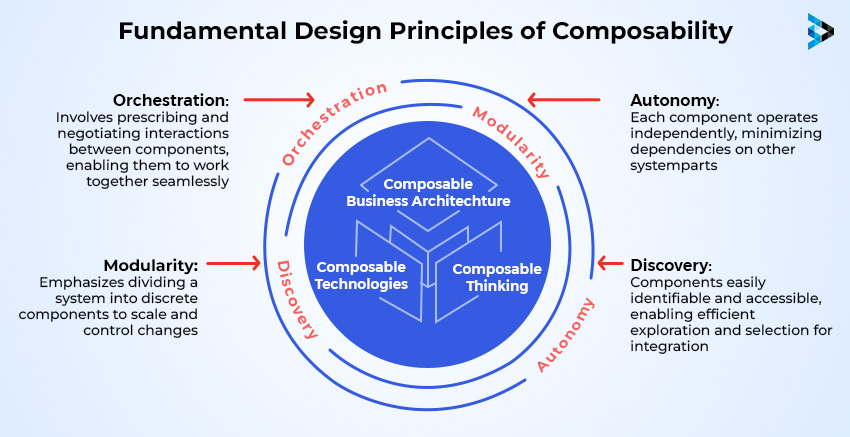
The Adobe Composable Commerce Platform serves as a solid foundation for adobe b2b commerce composable approach, ensuring smooth integration and communication among the many components of the ecommerce ecosystem. Using this basis, organizations can simply integrate and orchestrate various services, such as content management, product information management, and order management, to provide a personalized and cohesive client experience.
Modular by Design
The Adobe Composable Commerce Platform was developed by Magento Open Source to be modular, making it simple for companies to include, eliminate, or change components at will. This type of architecture allows organizations to construct and adjust their eCommerce solution by selecting only the characteristics and abilities they need for their business goals and end-users.
This modular MACH architecture provides numerous advantages, including:
- Agility– Enterprises may rapidly respond to market changes and shifting customer requirements by swapping elements.
- Scalability– The vendor may expand the platform as their company grows by adding or updating components, eliminating the necessity to rebuild the entire system.
- Cost-effectiveness– Businesses may spend only on the features and services they need, eliminating the overhead of a one-size-fits-all solution.
API-first Approach
The Adobe Composable Commerce is built with an API-first approach, meaning that every feature and every piece of data is accessible through a robust collection of APIs. Since the architecture is API-driven, the system easily connects to other programs and services to develop a personalized eCommerce ecosystem that is perfect for one’s business.
The API-driven development has various advantages:
- Flexibility: Other best-in-class solutions like CMS, CRM or marketing platforms can be easily integrated with the platform.
- Extensibility: It can be extended or modified to fit any unique business processes hence ideal for any company.
- Interoperability: With an API first design, data interchange and communication between different components of the eCommerce ecosystem become seamless leading to a unified user experience that is more streamlined.
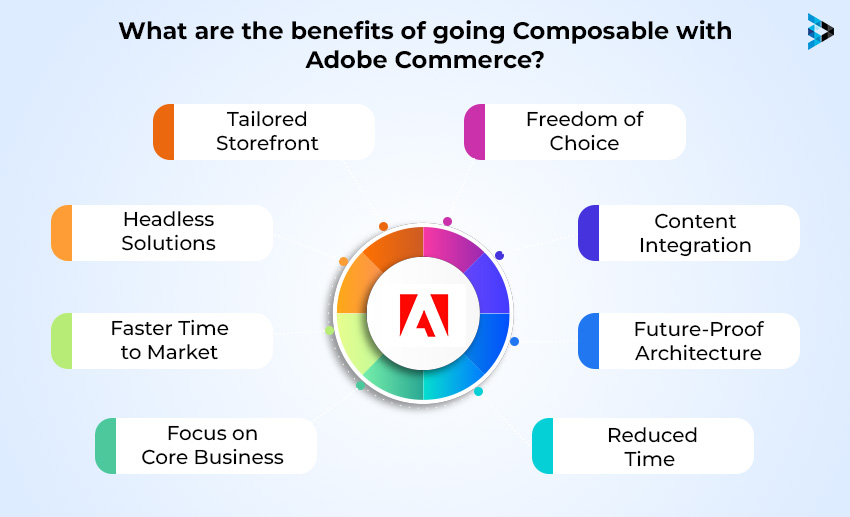
What are the benefits of going Composable with Adobe Commerce?
An Elastic Path poll conducted in March 2023 found that 72% of US retailers were already advancing commerce, with another 21% lining up to do so over the next year . Throwing on a Adobe composable commerce hat carries a plethora of consumer benefits and provides the greatest comprehensive way to transform one’s company’s eCommerce strategy:
Tailored Storefront
Businesses that go composable with Adobe Commerce can develop a customized storefront that exactly corresponds with their brand identity and customer preferences, improving the whole purchasing experience. It also stores the data of customization in its Adobe Commerce Cloud so that businesses can use it whenever they need.
Freedom of Choice
The use of composable architecture allows companies to choose and incorporate single, most suitable solutions for unique business requirements, thus giving them flexibility and scalability without having to rely on a monolithic system.
Headless Commerce Advantage
With this strategy, businesses can adopt headless commerce so as to create unified experiences across multiple channels that are seamless while at the same time being more flexible and adaptable with different touchpoints.
Content Integration
Composable architecture enables easy integration of content management systems, allowing businesses to deliver interesting and tailored content alongside their products, increasing customer engagement and conversion rates. All this information related to content integration is saved in Adobe Experience Cloud storage which is used as per the need of the company.
Future-Proof Architecture
To future-proof their eCommerce infrastructure, businesses are advised to adopt a modular approach that can be customized as per the market dynamics, technological advancements and customer demands without complete re-platforming.
Faster Time to Market
By enabling the rapid development and release of new capabilities, composable design trims down the time required to bring products onto the market. This gives organizations a competitive edge over others within their industry while also meeting evolving consumer needs.
Reduced Development Time
By re-purposing modular components during application creation, a composable strategy eliminates redundant tasks thereby making them faster and cheaper. Additionally, it allows development teams of an Magento ecommerce development company to work smarter not harder by streamlining processes for maximum efficiency gains which could eventually lead into quicker delivery times at reduced costs.
Focus on Core Business
Businesses that use an Adobe partner for composable architecture may focus on their core skills and strategic ambitions while leaving technical complexity to Adobe Commerce’s flexible and adaptable infrastructure, resulting in growth and innovation.
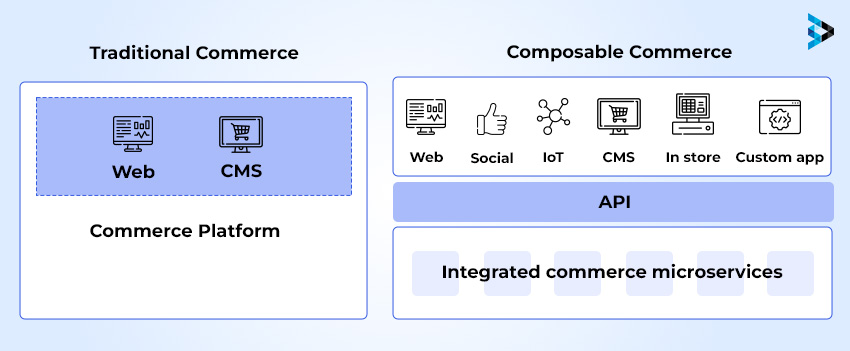
Composable Commerce vs Traditional Commerce
Traditional commerce refers to the usual architectural method of creating ecommerce platforms as a single integrated system, sometimes known as a “monolithic” system. This architecture combines the front-end presentation layer, back-end business logic, and database into a single entity.
Whereas, Composable commerce represents a break from the old model. It uses a headless Magento, which separates the front-end presentation layer from the back-end commerce logic. The back end is organized into packaged business capabilities or services that may be “composed” together.
The Traditional Commerce and Composable Commerce has the following major differences:
| Feature | Traditional Commerce | Composable Commerce |
| Concept | Single, monolithic platform handling all aspects of the ecommerce store (products, checkout, etc.) | The building block approach uses independent software components from various vendors (APIs for communication). |
| Pros | Simpler setup and management (often drag-and-drop interfaces, pre-built functionalities).Lower upfront costs | Extreme flexibility (choose functionalities from different vendors for a custom store).Faster innovation (leverage pre-built components and APIs for quicker launches and feature integration).Improved customer experiences (personalization across channels, omnichannel experiences).Future-proof architecture (easy integration of new technologies, replace outdated components).Scalability (independent scaling of specific components for smooth operations during peak traffic). |
| Security | The vendor is responsible for the security of the platform. | Requires careful security considerations across various components. |
| Data Management | Data typically resides within the vendor’s platform. | Requires a data management strategy for components from different vendors. |
| Examples | Shopify, BigCommerce | Adobe Composable Commerce, headless commerce |
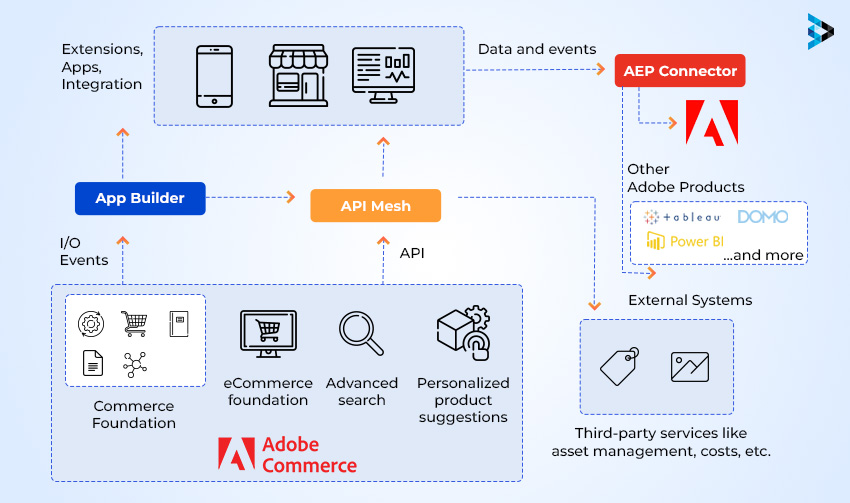
How can I go composable with Adobe Commerce?
It is essential to comprehend the idea and advantages of composable commerce before utilizing Adobe Commerce for your business. Businesses can select best-of-breed building components for their eCommerce infrastructure and enhance consumer experiences by using composable commerce. The composable history of Magento, which supports modules and extensions for a range of features like content management, search, catalog management, product information management, and customer relationship management, can be used with flexibility.
With over 500 REST and GraphQL APIs, Adobe Commerce lays the groundwork for composable commerce by empowering developers to create and deploy app-like experiences quickly across a variety of platforms, including single- and multi-page web apps, mobile apps, IoT devices, and VR/AR devices. With this flexibility, companies can design custom eCommerce experiences by integrating with third-party frontends and other Adobe products and delivering customizable functionality across all presentation layers.
We have expertise with Adobe Commerce as an Adobe Solution Partner to assist companies in reaching their eCommerce objectives. Because of our proficiency with modular commerce, we can help customers choose the ideal building blocks for their particular requirements and create a smooth, customer-focused eCommerce infrastructure.
You must evaluate your business objectives and pinpoint the areas in which you wish to enhance client experiences before implementing composable commerce with Adobe Commerce. In close collaboration with you, our team of specialists will ascertain your needs and devise a personalized plan to execute composable commerce.
The use of Adobe Headless Commerce with the composable commerce method will significantly improve the overall customer experience, conversion rate, and eCommerce performance. Adobe Solution Partner: Our mission is to enable our clients to successfully implement composable commerce to achieve their eCommerce goals. Additionally, leveraging Adobe Experience Manager services can further enhance digital experiences by ensuring seamless content management and personalized customer interactions.
It is clear that adopting composable commerce using Adobe Commerce can provide eCommerce companies with unmatched flexibility and possibilities for customization. By judicious choice of building blocks and leveraging Adobe’s rich libraries, businesses can easily construct differentiated, user-centric experiences that facilitate growth and success. We are an Adobe Solution Partner and will help companies achieve eCommerce objectives through the complex world of composable commerce.
To take your eCommerce strategy to the next level using composable commerce to its best talk to us today!
[ Read More : Empowering Your Business with Analytics: Making Informed Choices Using Adobe Commerce Data ]
FAQS
To go composable with Adobe Commerce requires skills in API development, microservices architecture as well as front end development frameworks such as React or Vue.js. Developers need to know how they can use many third party services together with systems through rich APIs provided by Adobe Commerce. Additionally, having an experienced Magento developer for hire on headless CMSs, PWA development and cloud native deployment strategies would be an added advantage.
In a composable design managing relationships with many vendors is important which involves establishing clear channels of communication; coming up with service level agreements; and aligning integration activities. Setting one point for contact, putting change management protocols while fostering collaboration among others may help in quickening vendor management too. Regular performance reviews coupled by feedback loops ensures consistency thereby enabling continuous progress.
The API ecosystem of Adobe Commerce is broad and it simplifies the integration process of multiple parts. Developers can use various third-party systems in relation to CRM, PIM and marketing automation tools therefore REST and GraphQL APIs should be utilized. One can also streamline the integration process through microservices architecture implementation as well as containerization technology which also enhances scalability.
Maintaining data consistency across a modular architecture necessitates strong data governance and integration solutions. This could include putting in place master data management (MDM) solutions, establishing data synchronization protocols, and performing data validation checks. Using a centralized data layer or a data mesh strategy can assist maintain data integrity and smooth information flow between components.
Measuring ROI on composable with Adobe commerce involves many indicators such as faster time to market, improved operational efficiency, better customer experience and reduced technical debt. It’s possible to determine ROI by looking at cost savings from modular development; its impact on sales/conversions rates; long-term benefits for scalability/flexibility etcetera. The performance data should always be used when necessary to analyze and change strategies for composable regularly.
In order to start implementing a composable strategy using Adobe Commerce, organizations need first evaluate their existing tech stack against where best-of-breed approach can be most beneficially implemented in terms of modularity. Creating a clear composable commerce strategy, finding the appropriate partners and vendors, and following a phased deployment plan can all contribute to a successful transformation. Continuous training will have to go hand in hand with change management if you want any success for deploying composable commerce within your company culture but innovative thinking must also prevail throughout this process too.
Adobe offers a variety of resources to assist firms learn and deploy composable commerce with Adobe Commerce, including:
• Adobe Commerce’s documentation for headless and composable architectures
• Webinars and events around composable commerce best practices.
• Adobe Commerce Partner Ecosystem and Integration Marketplace
• Adobe-certified partners provide consulting and implementation services.
Furthermore, industry journals, online groups, and specialized composable commerce solution providers can provide useful insights and direction to organizations starting out on their composable journey with Adobe Commerce.
Related Articles
-
Deliver Winning Content at Scale with Adobe GenStudio for Performance Marketing
Marketing departments are under pressure to provide targeted content as budgets compress. Marketers must create compelling, successful campaigns with current and relevant content for all consumers, channels, and platforms. Generative
-
eCommerce Website Design: Things You Must Know For Web Development
Online shopping can be incredibly confusing when ecommerce has more than a dozen million users in every industry worldwide. However, according to Statista, by 2023, ecommerce will reach up to
-
Coupons: Discount-Driven Journey to Online Purchase
Coupon, the ultimate marketing gimmick has just got a new makeover with ecommerce and online sales. Offers, coupons, promotions, rewards, deals, and discounts are not just marketing words anymore, those




